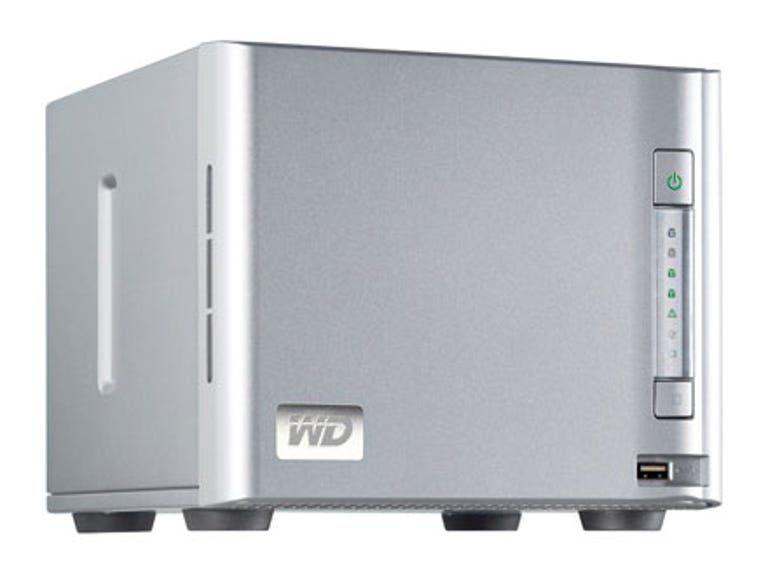 Why You Can Trust CNET
Why You Can Trust CNET WD ShareSpace review: WD ShareSpace
The WD ShareSpace NAS is a step up from the company's World Edition and while it performs well it's expensive and offers few features.
Though barely anyone knows the term, we think that the word "NAS" will become synonymous with "router" in the next few years. Though WD has had a product on the market for the last 18 months in the MyBook World Edition II, the ShareSpace is the company's first true NAS, and aimed at the home/SOHO market. It comes in two different versions: 2TB (AU$999) and 4TB (AU$1,699).
The Good
The Bad
The Bottom Line
Design
The company has seemingly abandoned its "book" analogy for the ShareSpace and gone with something that looks more utilitarian and professional. The look and size are equivalent to a Shuttle PC.
However, build quality isn't what you'd expect from an AU$1,700 device. While the cover is held on with captive thumbscrews, it comes off like a mid-90's PC with the clanging and chaos that it conjures up. Inside is where things get dicey though. Simply put, the green "handles" on each drive are rubbish. They flex horribly and aren't even held on properly — they are only "attached" by a small pin, not even screwed in. We expected better.
Features
As these products go, the ShareSpace offers a bare-bones feature set that is more in keeping with the small office market it is targeting. While the smaller 2TB drive is more within a consumer price bracket the WD misses some of the home network functions present on solutions by QNAP and D-Link. The most consumer-orientated feature is the onboard iTunes server, but unfortunately there's no UPnP server for devices like the PlayStation 3. Besides that, the other expected features include a built-in FTP server, automated downloader, MioNet remote access software, three USB 2.0 ports for external storage with push-button transfer and e-mail alert system.
As you'd expect, the 2TB version comes with two 1TB WD GreenPower drives, while the 4TB features four. RAID features include RAID 0 (Striped), RAID 1 (Mirrored) and RAID 5, while the 4TB version we received came presinstalled with RAID 5 (2.66GB useable). Connection to the network is via Gigabit ethernet.
Performance
We found the device was easy to install, with the disk-based installation quick and straightforward. Unlike some cheaper "NAS" devices, the WD install is only a finder and doesn't install any software on client machines — it simply lets you assign the ShareSpace to an IP address on the network. You can then assign network drives as local shares on each machine. Of course, if your router is prone to falling over you may lose your shares due to the fact they are IP based, and have to rerun the install disk, as we found.
The WD may feature a download facility, but don't get too excited, this is not a Bittorrent client — it's an automated http/ftp downloader. While businesses may have a use for this function if they're willing to risk unknown file sizes, it's a little beyond consumers. Accessing the feature was also a little difficult, as for some reason — and this is not listed in the manual — the user name for downloader is not "admin", and actually "downloader".
Having found WD's MyBook World Edition II to be horrendously noisy we were pleasantly surprised to find the drives were very quiet.
The iTunes server worked well, but only on machines that were mapped to the drive already, and the server can be set to look for new music on the drive in increments from 5 minutes up to a day.
We found the machine to be relatively quick in transferring files across a network. We used a 1.09GB test file on both a 10/100 and a Gigabit network and found the drive was really able to take advantage of the additional bandwidth. On the gigabit connection our RAID 5 machine was capable of a 23.8 MB/s transfer rate when reading, and a quite a bit slower at writing: 13.19 MB/s. On the slower network, the read and write speeds were more in line but slower: read 10. MB/s and write 9.44 MB/s.
Conclusion
The WD ShareSpace performs well and is easy to set up, but apart from remote access there aren't many features to speak of — especially for consumers. And the price! At AU$1,700 it would be out of the reach of most people — especially when you could simply buy the 2TB version and buy the extra drives yourself for only AU$1,399. As we reviewed the 4TB this is the version we are scoring, but we would probably score the 2TB at a 7.2. There are plenty of other, better NAS systems out there.



